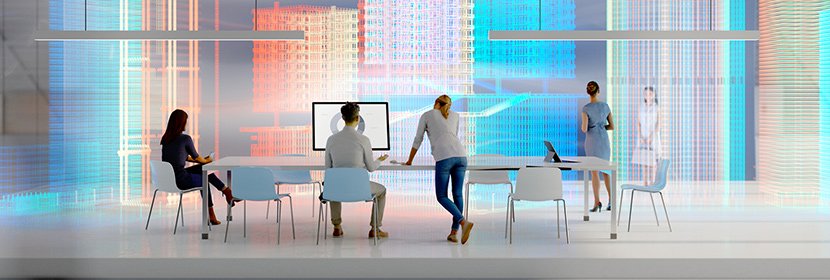Augmented Reality in IT Support—The Future of Training and Troubleshooting

Whether you’re a corporate executive, an enterprise manager, or a small business owner, it’s important to understand the necessity of keeping up with new technology. That’s if you don’t want to be left behind by competition. Add to this the continued shift to remote work and the growing reliance on virtual collaboration, and you’ve got a business landscape that’s ever evolving. One that, more than ever, needs reliable IT support. That’s why it’s essential for IT teams to innovate and find new solutions. This way, they can help users maintain productivity, and contribute to the organisation’s goals.
One promising technology on the horizon is augmented reality (AR), which is increasingly being integrated into tech support solutions. AR has the potential to revolutionise IT support and training by providing real-time assistance no matter where an employee is located. In this article, we’ll explore how AR can be used in IT support and its potential for the future of tech support.
But let’s start with,
What is Augmented Reality?

Augmented reality is a type of technology that overlays digital content—text, images, videos, 3D models, etc. into the real world environment. AR typically works through smart
devices and displays like mobile phones, tablets, TVs, and custom AR glasses equipped with cameras and sensors.
By capturing the user's surroundings and superimposing digital content, these devices create an augmented perception of reality. The seamless combination allows users to interact with both real-world information and digital information simultaneously. No wonder AR technology is growing—and fast.
Augmented reality is a closely-related technology to virtual reality (VR), but with some distinct differences. AR merely enhances the real world with digital elements. For instance, a user may utilise an AR app for interior design by pointing a smartphone at certain parts of a room. The app would then overlay furniture, decor, and paint colours to try out the effect in live view. In contrast, VR completely immerses users in a digitally-created environment, generally with the use of a headset.
How AR is Used in IT Support

AR technology in IT support is primarily used to facilitate troubleshooting, technical assistance, and user training activities. To be able to do this, AR support applications utilise a combination of AR technology, camera-sharing, and audio features. These features have proven to be valuable in:
-
Remote Troubleshooting. Technicians can use AR to guide users through step-by-step troubleshooting procedures. This can be done by overlaying instructions or visual guides onto the user's screen. Diagnosing and resolving technical issues are thus accomplished by support professionals without being physically present.
-
Providing Visual Aids. Hardware repairs and system configurations can be difficult to complete without visual cues, especially for the less tech-savvy users. AR tools help simplify complex procedures by displaying 3D models, diagrams, or animations on the user’s device, allowing the graphic references to guide users in accurately locating the right hardware parts or system locations.
-
Conducting Technical Training. Using AR-powered software, IT professionals can take advantage of tech assistance training that is more simplified and understandable. They can do this by using AR-based interactive tutorials and simulations overlaid into real-life objects and environments. This way, they can learn crucial skills and troubleshooting techniques under a simulated environment.
-
Enabling Virtual Collaboration. Some technical issues may be tough to resolve and would require consultation with other IT experts. AR support tools allow multiple parties to view and interact with the same augmented environment and objects simultaneously. A virtual collaboration such as this improves communication and enhances problem solving efficiency, expediting the issue resolution.
Benefits of AR Technology in IT Support

There will certainly be more uses of augmented reality in IT support as the technology matures. As it is right now, there are already several benefits to leveraging the potential of AR in technical support. These include:
-
Immediate support anytime, anywhere. AR technology makes it possible for support teams to provide assistance to employees in real-time, regardless of where the technician and the user are located. The IT professional’s virtual presence is enough because it’s easier for him or her to make an exact diagnosis using the augmented information provided by the tool.
-
Quick and accurate troubleshooting. With the aid of augmented reality, not only is an accurate diagnosis assured, the fast resolution of that problem is highly probable too. Instead of relaying troubleshooting instructions over the phone where miscommunications can easily happen, the technician can remotely access the device using AR and lead them through the detailed process of fixing the issue. The quick turnaround saves a lot of time, reduces downtime, and increases employee productivity.
-
Practical interactive training. Learning how to deploy new applications or setting up new hardware can get quite tedious with your usual, run-of-the-mill training lectures. Getting hands-on instructions and interactive tutorials with the use of AR headsets on the other hand, can make the learning/training process more enjoyable, and the new information easier to digest and remember.
The Future of AR Integration into IT Support

Augmented reality may still be in its early stages when it comes to integration with IT support. But it’s a technology that’s advancing fast, and showing a lot of promise for tech support services. For instance, we may potentially see AR-embedded smart glasses for technicians that could display real-time status alerts, give ticket updates, and even monitor system performance.
While we wait for these developments however, the AR technology’s current ability to provide real-time, accurate troubleshooting assistance is one well worth considering. To know more about AR-powered solutions and how they could benefit your organisation, talk to your managed services provider today.
Related Posts
By accepting you will be accessing a service provided by a third-party external to https://www.htl.london/